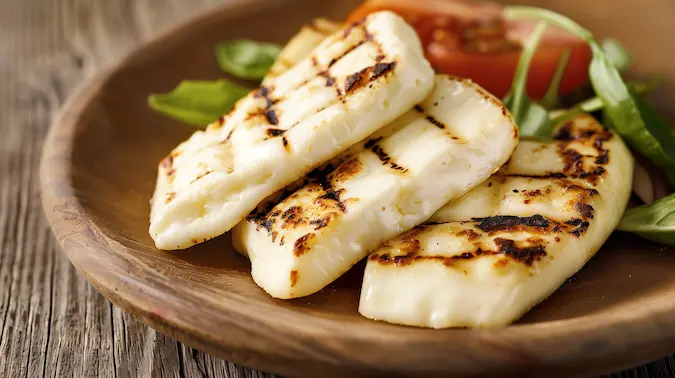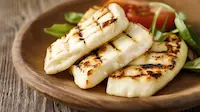What is Halloumi Cheese?
Halloumi is a semi-firm, unripened, brined cheese originating from Cyprus. Renowned for its high melting point, it maintains its shape when heated, making it ideal for grilling or frying. The cheese is traditionally made from a blend of sheep's and goat's milk, though modern versions may also incorporate cow's milk. Halloumi's unique taste is salty and tangy, with a hint of creaminess that has made it a favorite in culinary circles worldwide.
Understanding halloumi is key to appreciating its versatility in the kitchen. This cheese is not just a delight on the grill; its robust texture and ability to absorb flavors make it a standout ingredient in a variety of dishes. From its origins to its nutritional profile, Halloumi offers a rich tapestry of culinary potential. Knowing how to store and prepare it can transform your meals and introduce a new protein option for vegetarians.
Let's explore how Halloumi cheese is crafted and what gives it its distinctive character.
How is Halloumi cheese made?
Halloumi cheese is made through a series of meticulous steps that begin with the pasteurization of a mixture of sheep's, goat's, and sometimes cow's milk. Rennet is then added to coagulate the milk into curds, which are subsequently cut, heated, and shaped. The curds are set in molds to form the cheese's final shape and are then cooked until they reach a firm consistency. Finally, the cheese is brined to develop its characteristic salty flavor and to preserve it.
Here is a detailed breakdown of the Halloumi cheese production process:
Production Process of Halloumi Cheese
| Step | Description | Ingredients | Temperature | Duration |
|---|---|---|---|---|
| 1. Pasteurization | Milk is heated to eliminate bacteria and enzymes. | Sheep's, goat's, cow's milk | 65-72°C (149-161°F) | 15-30 seconds |
| 2. Coagulation | Rennet is added to milk to form curds. | Rennet | 32-34°C (90-93°F) | 30-40 minutes |
| 3. Curd Processing | Curds are cut, stirred, and heated to expel whey. | - | 38-40°C (100-104°F) | 20-30 minutes |
| 4. Molding and Pressing | Curds are placed into molds to shape the cheese. | - | Room temperature | 2-3 hours |
| 5. Cooking | Shaped curds are cooked until firm. | - | 85-90°C (185-194°F) | 30-40 minutes |
| 6. Brining | Cheese is submerged in brine solution to develop flavor and preserve. | Salt, Water | Brine temperature | At least 24 hours |
Halloumi Cheese Profile
Each cheese tells its own story, and Halloumi is no exception. With its firm texture and unique ability to resist melting, Halloumi has captivated the taste buds of food lovers around the globe. But beyond its culinary prowess, Halloumi has a rich heritage and a set of characteristics that define its identity in the world of cheese.
- Made from: Sheep's and goat's milk, often with cow's milk added
- Country of origin: Cyprus
- Region: Island-wide, with a concentration in the central and eastern areas
- Family: Pasta filata
- Type: Semi-firm, unripened
- Texture: Squeaky and rubbery when fresh, firmer when grilled or fried
- Rind: None
- Colour: White
- Flavour: Salty, tangy, with a touch of creaminess
- Aroma: Mild, milky
- Vegetarian: Often, but check for non-animal derived rennet
- Producers: Numerous across Cyprus, with both artisanal and industrial scale operations
Origin: Where does Halloumi cheese come from?
Halloumi cheese comes from Cyprus, an island nation steeped in history and culinary tradition. This cheese has been a staple in Cypriot cuisine for centuries, with its origins tracing back to the Byzantine era. Over time, Halloumi has become a symbol of Cypriot culture, enjoyed not only on the island but also savored by cheese aficionados around the world.
How to store Halloumi cheese?
Proper storage of Halloumi cheese is vital for maintaining its quality and extending its shelf life. Halloumi should be kept in its original packaging until ready to use. Once opened, submerge it in brine or salt water in an airtight container to keep it moist and preserve its flavor. Store the container in the refrigerator to ensure the cheese remains fresh and delicious.
- Initial Storage: Keep in original packaging in the refrigerator.
- After Opening: Place cheese in an airtight container.
- Brine Solution: Submerge cheese in brine (salt water).
- Refrigeration: Store container in the refrigerator.
- Container: Use airtight containers to prevent odors.
How long does Halloumi cheese last?
Halloumi cheese's longevity depends on its storage conditions. When stored properly, sealed Halloumi can last up to a year in the refrigerator. Once opened and placed in brine, it can be enjoyed for several weeks. Freezing Halloumi is possible, but it may alter the texture and taste upon thawing, often becoming crumblier and less flavorful.
| Storage Condition | Duration | Texture After Thawing | Taste After Thawing |
|---|---|---|---|
| Refrigerator (sealed) | Up to 1 year | N/A | N/A |
| Refrigerator (in brine) | 2-3 weeks | N/A | N/A |
| Freezer | Up to 3 months | Crumblier | Less flavorful |
Next, we will explore alternatives to Halloumi cheese.
Can you freeze Halloumi cheese?
Yes, you can freeze Halloumi cheese. Freezing can extend its shelf life, making it a convenient option for long-term storage. However, freezing may change its texture, making it crumblier, and it might lose some of its flavor. For best results, consume Halloumi within three months of freezing and thaw it in the refrigerator before use.
Alternatives to Halloumi Cheese
While Halloumi's unique characteristics make it a standout choice for many dishes, there are instances where a substitute may be necessary. Whether due to availability, dietary preferences, or simply to explore different flavors and textures, various cheeses can serve as suitable alternatives. Below is a table detailing some of the best substitutes for Halloumi and why they make a good match.
Halloumi Cheese Substitutes
| Cheese | Origin | Milk Source | Texture | Flavor | Melting Point | Best Used In |
|---|---|---|---|---|---|---|
| Paneer | India | Cow's or buffalo's milk | Firm, crumbly | Mild, milky | High | Grilling, stir-frying |
| Queso Panela | Mexico | Cow's milk | Firm, moist | Fresh, milky | High | Grilling, salads |
| Feta (baked) | Greece | Sheep's milk or a blend with goat's milk | Crumbly, soft | Tangy, salty | High when baked | Baking, salads |
| Kefalotyri | Greece | Sheep's or goat's milk | Hard, dense | Salty, piquant | High | Sautéing, grating |
| Provolone | Italy | Cow's milk | Semi-firm | Sharp, tangy | Medium | Melting, sandwiches |
Halloumi Popular Comparison
When considering alternatives to Halloumi, it's often compared to mozzarella for its similar qualities and uses.
Halloumi vs. Mozzarella Comparison
| Cheese | Origin | Milk Source | Texture | Flavor | Aging Time | Uses |
|---|---|---|---|---|---|---|
| Halloumi | Cyprus | Sheep's, goat's, cow's milk | Semi-firm, rubbery | Salty, tangy | None to short | Grilling, frying |
| Mozzarella | Italy | Buffalo's or cow's milk | Soft, moist | Mild, creamy | None to short | Melting, salads |
WhatCheese invites you to explore how to use Halloumi in your next culinary creation.
How to use Halloumi Cheese
With its high melting point, Halloumi cheese is a versatile ingredient that can be enjoyed in various forms. To prepare Halloumi, slice the cheese into 1/2-inch-thick pieces. These can be grilled, fried, or incorporated into dishes where they can absorb other flavors while adding a unique texture and taste. When grilling or frying, cook each side until golden brown, which typically takes 2 to 3 minutes per side. Halloumi is also delicious when served cold, adding a chewy texture to salads and sandwiches.
- Grilling: Brush slices with olive oil and place on a hot grill.
- Frying: Pan-fry slices in a bit of oil over medium heat.
- Serving cold: Cut into cubes and add to salads or skewers.
- Baking: Incorporate into casseroles or bake until golden.
- Marinating: Soak in a mixture of herbs and oil before cooking.
How to serve Halloumi Cheese
Halloumi cheese is best served warm, straight off the grill or out of the pan, to savor its crispy exterior and soft interior. It pairs well with a drizzle of lemon juice or a sprinkle of za'atar. For a refreshing contrast, serve alongside a crisp salad or with juicy watermelon slices. Halloumi can also be the star of a cheese platter, complemented by a selection of fresh fruits, nuts, and a variety of dips.
Next, we will explore recipes that highlight the unique qualities of Halloumi cheese.
Recipes using Halloumi Cheese
Recipes featuring Halloumi capitalize on its robust texture and savory flavor, making it a versatile star in many dishes. Its ability to be grilled or fried without melting allows for a range of culinary applications, from appetizers to main courses.
- Grilled Halloumi Skewers: Alternating with vegetables, Halloumi grills to perfection on skewers, offering a smoky, charred edge that complements its salty taste.
- Halloumi Salad: Slices of fried or grilled Halloumi add a protein-rich, flavorful component to leafy greens or grain-based salads.
- Halloumi Burgers: Used as a meat substitute, Halloumi provides a satisfying texture and flavor in vegetarian burgers.
- Halloumi Fries: Cut into sticks and fried until golden, these make a crispy, indulgent treat served with dipping sauces.
- Halloumi Breakfast Sandwich: A morning delight when layered with eggs and fresh tomatoes on a toasted bun.
WhatCheese invites you to explore the nutritional data of Halloumi cheese next.
Halloumi Cheese Nutrition Data
Understanding the nutritional content of Halloumi cheese is important for those mindful of their dietary intake. There are 321 calories in Halloumi cheese per 100g. This cheese is also a rich source of protein and calcium, but it's high in fat and sodium, which should be considered in the context of an overall balanced diet.
| Nutrient | Amount per 100g | % Daily Value* |
|---|---|---|
| Calories | 321 | - |
| Total Fat | 24g | 37% |
| Saturated Fat | 15.6g | 78% |
| Cholesterol | 68mg | 23% |
| Sodium | 330mg | 14% |
| Total Carbohydrates | 1.8g | <1% |
| Dietary Fiber | 0g | 0% |
| Sugars | 1.8g | - |
| Protein | 21g | 42% |
| Calcium | 700mg | 70% |
*Percent Daily Values are based on a 2,000 calorie diet. Your daily values may be higher or lower depending on your calorie needs.
WhatCheese will now guide you through insights into the future of Halloumi cheese.
What's next? WhatCheese insights
As a passionate advocate for cheese culture, I've observed Halloumi's rising popularity and its integration into diverse culinary traditions. If you are looking to purchase this versatile cheese, specialty cheese shops and well-stocked supermarkets often carry Halloumi, particularly in areas with a strong interest in Mediterranean cuisine. Online retailers are also a convenient source, offering a variety of Halloumi options, including organic and flavored varieties.
For a truly immersive experience, renowned vineyards often pair their wines with a selection of cheeses, including Halloumi. Wine and cheese tastings provide an opportunity to explore how the salty and tangy profile of Halloumi complements different wine varietals. Vineyards in regions known for their wine production, such as Napa Valley in California and the Bordeaux region in France, frequently host such events.
Moreover, cheese festivals and culinary events are excellent venues to savor Halloumi and learn from cheesemongers about its best pairings and uses. These events often showcase cooking demonstrations, offering new and exciting ways to incorporate Halloumi into your cooking repertoire.
Renowned Vineyards Offering Cheese Tastings
| Location Name | Location | Best Time to Visit | What They Offer |
|---|---|---|---|
| Chateau Elan | Braselton, GA | Spring-Fall | Wine and cheese pairings, tours |
| Castello di Amorosa | Calistoga, CA | All year | Italian-style wines, cheese pairings |
| Domaine Carneros | Napa, CA | All year | Sparkling wines, curated cheese selections |
For those who appreciate the firmness and versatility of Halloumi, other cheeses such as Paneer, Queso Panela, and Kefalotyri offer similar qualities that can be used in a wide range of dishes. These cheeses also hold up well to grilling and frying, making them excellent alternatives for those looking to expand their culinary horizons.
Let's now turn our attention to unanswered questions that may arise from our exploration of Halloumi cheese.





